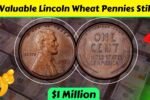Join on WhatsApp
Get the latest updates directly on WhatsApp – motivation, news & more!
Among the many treasures hidden in everyday currency, few coins hold as much fascination as the legendary 1943 Lincoln Wheat Penny. Estimated to be worth up to 11 million dollars, this rare coin is considered one of the most valuable minting mistakes in American history. What makes it even more thrilling is the possibility that an undiscovered specimen may still be hiding in circulation, waiting to be found by an unsuspecting person.
Origins of the Lincoln Wheat Penny
The Lincoln Wheat Penny was first introduced in 1909 to celebrate the 100th anniversary of Abraham Lincoln’s birth. Featuring Lincoln’s portrait on the front and two wheat stalks on the reverse, it quickly became a familiar part of American currency. Produced until 1958, these pennies were widely circulated and became a cultural symbol. For collectors, the standard wheat penny holds nostalgic value, but the rare variations such as the 1943 bronze version elevate the coin to legendary status.
A Wartime Necessity That Changed Coin Production
During World War II, copper was urgently needed for military equipment, leading the U.S. Mint to replace copper-based pennies with steel versions coated in zinc. This change in 1943 resulted in a silvery-looking penny. Yet in the process, a handful of bronze blanks were mistakenly struck with the 1943 date. These error coins, created unintentionally during the transition, have since become some of the most sought-after collectibles in numismatic history.
Why the 1943 Bronze Penny Is So Rare
Experts believe only 15 to 20 genuine bronze pennies from 1943 exist today. The extreme rarity, coupled with their historical context, has driven their market value to extraordinary levels. When one appears at auction, it attracts worldwide attention and often sets record prices. The combination of rarity, condition, and historical significance explains why collectors are willing to pay millions to own one.
The Search for the Missing Penny
The possibility that at least one bronze penny from 1943 may still be in everyday circulation fuels the excitement around this coin. Treasure hunters, hobbyists, and even casual collectors often check their change and coin jars in hopes of stumbling upon the elusive treasure. The idea that an ordinary penny could secretly be worth millions has inspired countless people to take a second look at their pocket change.
Key Features That Help Identify the Coin
To recognize an authentic 1943 bronze penny, collectors look for several telltale signs. Unlike the shiny steel pennies from that year, the bronze coin has a brownish-red tone. A quick magnet test provides another clue, since bronze pennies do not stick to magnets, whereas steel ones do. The date must read 1943, and the presence of a mint mark can further help identify its origin. Each of these details plays an important role in authenticating the coin.
How the Coin Shaped Collecting Culture
The story of the 1943 bronze penny has inspired new generations of collectors to explore numismatics. It has also sparked interest in error coins, reminding people that rare treasures often arise from simple human mistakes. Coin shops and online platforms regularly see increased activity as enthusiasts search for valuable pieces, with the dream of finding a once-in-a-lifetime discovery driving their passion.
More Than Just Money
While the multimillion-dollar value captures the spotlight, these coins represent more than financial gain. They are physical reminders of a time when the nation was focused on the war effort, adapting industry to meet urgent needs. Each surviving penny tells a story of resource allocation, human oversight, and the unexpected ways history can leave its mark. For both historians and collectors, the 1943 bronze penny stands as a bridge between everyday life and extraordinary history.



